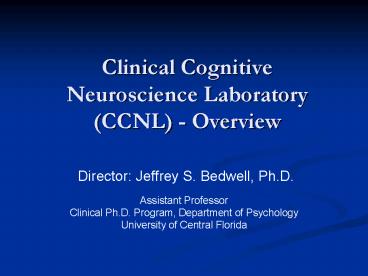Clinical Cognitive Neuroscience Laboratory CCNL Overview PowerPoint PPT Presentation
1 / 11
Title: Clinical Cognitive Neuroscience Laboratory CCNL Overview
1
Clinical Cognitive Neuroscience Laboratory (CCNL)
- Overview
- Director Jeffrey S. Bedwell, Ph.D.
- Assistant Professor
- Clinical Ph.D. Program, Department of Psychology
- University of Central Florida
2
Background of Main Line of Research
- Previous research has suggested a dysfunctional
magnocellular (M) visual pathway related to
schizophrenia. - Literature from basic vision research has
demonstrated that diffuse red light suppresses
activity in the M pathway. - Initially shown with single-cell recording in
monkeys - Later inferred in humans via performance changes
to M pathway tasks with a red background
3
Initial Findings First-Degree Relatives of
Persons with Schizophrenia
Visual Backward Masking with Red Background
z 2.77, p .01, Cohens d 0.66
Bedwell, Brown, and Miller (2003) Schizophrenia
Research
4
Findings in First-Degree Relatives fMRI with
Red Light
Group difference in change in relative right
hemisphere V5 (MT) in response to a red,
compared to green, background, t 2.43, p .02,
Cohens d 1.00.
Controls (N 11)
Relatives (N 13)
Bedwell, Miller, Brown, and Yanasak (2006)
International Journal of Neuroscience
5
Aim of Current Study
- While this red light effect has been
demonstrated in first-degree relatives no
published research as explored this effect in
individuals with schizophrenia. - Hypothesis Individuals with schizophrenia will
show the opposite reaction of accuracy in
backward masking performance in response to a
red, relative to green, background as compared
to controls.
6
Demographics Current Study
- Schizophrenia inpatients (N 15)
- Age mean 39.59, SD 10.87, range 26 to 60
- Gender 12 males, 3 females
- Race 10 Caucasian, 4 African American, 1
Hispanic/Latino - Nonpsychiatric Controls (N 16)
- Age mean 42.36, SD 11.00, range 24 to 60
- Gender 10 males, 3 females
- Race 10 Caucasian, 3 African American, 2
Hispanic/Latino, 1 Asian
7
Location Backward Masking Task
Target (13 ms)
Mask (27 ms)
9 stimulus onset asynchrony (SOA) durations
12 trials presented at each SOA (random selection
by trial) Also, 12 unmasked trials Task presented
on both a red and green background (matched for
physical luminance) counterbalanced order by
participant
8
Results
Bedwell, Orem, Rassovsky, Allen, and Sutterby (in
press) Psychiatry Research
9
Results from Schizotypy Sample
Bedwell and Orem (in press) Cognitive
Neuropsychiatry
10
Future Directions
- Explore whether green light actually helped to
fix baseline M pathway hypoactivity in the
schizophrenia participants. - Addition of a third, gray, comparison background.
- Use event-related potentials (ERP) to explore the
relative strength of M and P pathway activity
within each color condition. - Explore group differences
- Conduct heritability studies on this effect
11
Other Research in Lab
- Olfaction and emotion processing in schizophrenia
(Vidya Kamath) - Cognition and emotion processing as related to
delusion symptoms (Diana Orem) - Neuropsychological correlates of social phobia
(Scott Sutterby) - Neuropsychological correlates of chronic stress
in older adults (Diane Petrac) - Two new grad students to focus on schizophrenia
Doug Dykstra and Andrew Deptula

